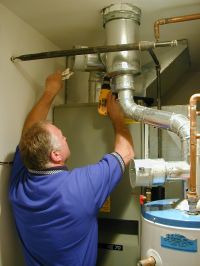Most of us wrestle with frustration when it comes to solving problems related to water heater pilot outages. Some of us admit we often give it a half-hearted effort because we think the problem should be fixed by the utility company or someone else. When in many cases they have already tried to fix the problem and were unsuccessful.
After reading this article, I hope you can face your next water heater problem with a renewed purpose and have some new knowledge to back it up.
Most of the time, it’s a combination of defects and installation conditions that cause the problem. First, let’s take a look at some of the initial mechanical issues that cause pilot problems that are fairly obvious:
- Bad thermocouple – wish they were all this easy
- Bad gas valve – costs about the same as the water heater
- Low gas supply – piping problem or street or tank gas pressure
- Dirty pilot, orifice, burner – fairly visible
- Dirt or debris floating inside the pilot line – can drive you nuts
- Blocked or restricted flue – don’t want pilot to stay lit
- Wind – can’t control the weather blowing out the pilot?
- Poorly positioned pilot – that’s the way it was made
- Burner out of alignment – bounced a little going down the stairs
- Pilot orifice is too small – it came that way
- Not Venting – mechanical room depressurization – duct or building
- Leakage
- Induced draft appliance common vented – blowing down during purge
You could say all these problems make a great case for spark or hot surface ignition but not when you look at safety. Most of the above problems are potential hazards that shouldn’t allow the water heater to operate. But they are problems that need to be eliminated. The frustration begins when we fix one of these problems and it creates another.
A Scenario That Can Drive You Crazy

You get called out for a water heater problem where there’s an induced draft furnace installed on the same flue with a conventional draft hood water heater. The furnace inducer intermittently blows out the water heater pilot during its pre-purge mode because it pressurizes the flue. You install a barometric damper on the furnace to relieve this pressure and the initial problem seems to be solved. But what happens if the flue becomes blocked? Both appliances could operate and neither one would shutdown on any safety. Therefore you can add a spill switch to the furnace barometric damper and several to the water heater draft hood to provide extra safety.
But now the pilot on the water heater keeps going out because you’re losing too much voltage through the spill switches on the water heater. If you remove the draft hood from the water heater and use a barometric damper then you only need one spill switch and that should help with the voltage drop.
Now the pilot is going out even more often. Apparently the barometric damper on the water heater is making the water heater draft better and it is causing the pilot to pull off of the thermocouple because of the pilot size and location. Okay so you make the pilot orifice bigger and re-position the pilot assembly so the pilot flame makes better contact with the thermocouple.
Everything is now working fine until the wind blows and poof the pilot is out again. This should be your last trip if you install a Star-Kap (wind-proof cap) but at this point the customer is giving you some strange looks. By the time you’re done, the repairs to keep the pilot lit cost more than the water heater.
It can be a dilemma if you piece it together like this. Is there one more problem that we haven’t discussed? Yep! What about excessive duct leakage when the air conditioning is running pulling the mechanical room into a negative and interfering with venting? This fix may be no more than a supply register on the plenum but it’s another trip and a possibly aggravated customer.
You might be thinking to yourself by now that if you hadn’t gone to that darn seminar you wouldn’t have messed with this in the first place! You were not the first and you won’t be the last, but no one gains if everyone just passes on the problem to someone else.
The main point to this story is you must recognize all the possibilities that can exist on any given job. With the exception of the wind, most of the problems can be uncovered with standard NCI testing protocols. The best approach on this job would have been to “Do it Right the First Time” by removing the draft hood, installing barometrics and spill switches, fixing combustion air problems, adjusting the thermocouple position and installing a wind-proof cap. Not only is this a profitable repair job, it insures maximum safety and eliminates callbacks. The key is to educate the customer about what you’re doing to keep their family safe.
Even if you don’t make all the changes up front at least you can advise the customer about the circumstances and let it become their decision on how to proceed.
